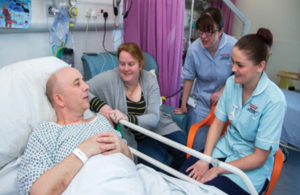Reducing catheter-associated UTI rates in hospital
Improvement project reduced catheter-associated urinary tract infection (CAUTI) rates at a district general hospital.

Photo of a relative and nurses around a hospital patient bedside
Summary
A strategy for improvement over 2 years reduced the rate of catheter-associated urinary tract infections (CAUTI) in Chesterfield Royal Hospital.
Background
In 2012 to 2013 data from the monthly national ‘Safety Thermometer’ revealed CAUTI rates were consistently double the national average. In March 2013, using a baseline point prevalence audit, we set out to improve this position via a Commissioning for Quality and Innovation (CQUIN) project.
What was involved?
A 6-step improvement programme was implemented over a 2-year period:
Step 1: Introduce a urinary catheter pathway
- incorporate standards required for catheter insertion and the on-going care and maintenance of the system
Step 2: Use a nurse-led urinary catheter-removal protocol - HOUDINI - which lists clinical indications when it is appropriate for the continued use of a catheter:
- haematuria - only requires catheter if in clot retention
- obstruction or retention
- urology surgery
- damaged skin - open sacral or perineal wound in an incontinent patient
- input and output, fluid monitoring
- nursing care end of life or comfort care
- immobility due to physical constraint, for example unstable fracture and unable to use bottles or bedpans
Step 3: Make a resource file available
- all adult in-patient wards provided with a resource file that utilised visual aids to support learning
Step 4: Train and educate
- registered nurses and health care assistants focusing on specific elements of catheter management including insertion, removal and ongoing care
Step 5: Review and standardise products
- working in partnership with Derbyshire Community Health Services to review and standardise continence products used in both primary and secondary care
Step 6: Continence promotion
- ward-based training with education sessions and a follow-up review of skills and knowledge
A comparison of audit data between March 2013 and January 2015 showed:
- a 30% reduction in the number of patients with a catheter
- a 71% reduction in the number of patients with a catheter who developed a UTI
What works well?
The trust invested in a 12-month full-time band 6 post to implement this project. This, along with commitment and determination, helped the project succeed.
Next steps
We now audit monthly compliance with HOUDINI across all adult in-patient areas, we use the Safety Thermometer principles of 16 patients audited in each area. We also verify all Safety Thermometer data collected for accuracy.
Further information
Email Diane Holland, Deputy Director of Infection Prevention & Control, Chesterfield Royal Hospital.
This case study features as shared learning on the NHS Improvement website.